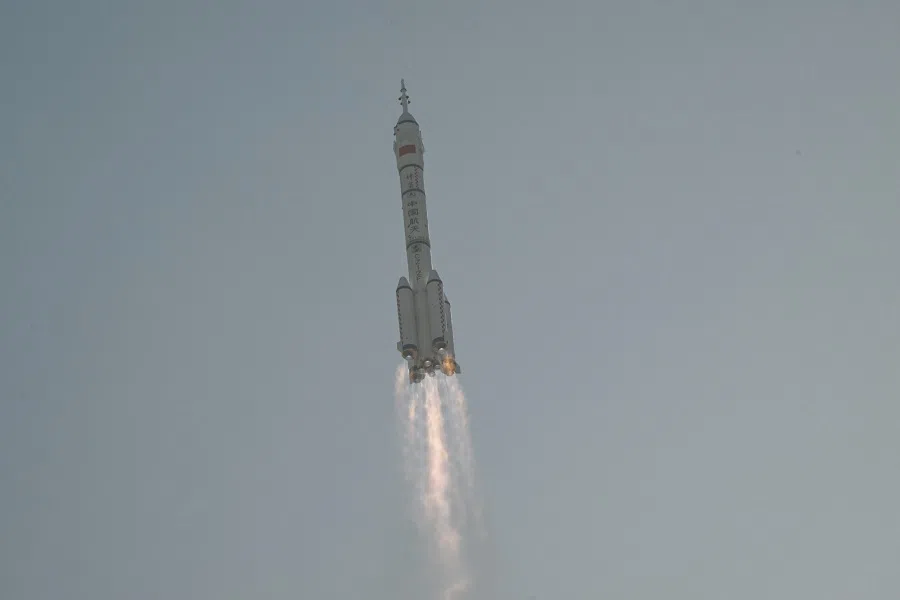China's strides in spaceflight put the US on notice
China's recent third launch of a reusable test spacecraft clearly demonstrates that China is closing the gap with the US in spaceflight technology. Its strides in remote sensing satellite technology would also help it achieve greater military conflict preparedness. Lianhe Zaobao correspondent Yu Zeyuan explains.

China has been flexing its muscles in space recently. After successfully launching a reusable test spacecraft via a Long March-2F carrier rocket on 14 December, it launched a new remote sensing satellite (Yaogan-41) into its planned orbit via the Long March-5 Y6 the next day. Both launches marked yet another breakthrough in the country's space technology.
Reusable spacecraft are spacecraft that can be reflown, can travel freely between the surface of the Earth and space, carry crew and payloads, and remain in orbit and manoeuvre for an extended period of time to accomplish a variety of missions. They include manned spacecraft, cargo spacecraft, space shuttles and so on.
This is China's third launch of a reusable spacecraft. The first time was on 4 September 2020, when it was in orbit for just two days; the second time was on 5 August 2022, when it returned to Earth after 276 days in orbit. This time, the reusable spacecraft is expected to stay in orbit for an even longer period and conduct more experiments.
Space surveillance going a notch up
Before China's most recent launch of a reusable spacecraft, the US's Space Exploration Technologies Corp (SpaceX) had already announced the launch of the US Space Force's X-37B space plane atop a SpaceX Falcon Heavy rocket, but the launch was delayed three times in one week for various reasons. SpaceX later said that it was targeting 28 Dec as the new launch date.

In an Air & Space Forces Magazine article published on 13 December, chief of space operations General B. Chance Saltzman had this to say about China's spacecraft launch: "It's no surprise that the Chinese are extremely interested in our space plane. We're extremely interested in theirs. Because it is a capability; the ability to put something in orbit, do some things, and bring it home and take a look at the results is powerful. And so these are two of the most watched objects on orbit while they're on orbit. It's probably no coincidence that they're trying to match us in timing and sequence of this."
Saltzman also called on the US Congress to provide necessary funding to keep the space programme going, and claimed that the X-37B space plane would operate at a higher orbit than ever before. He said, "There are some good experiments and tests and that's the primary goal of that, testing technologies. There are some experiments being run and we'll pull data back."
This would give the X-37B a bird's-eye view and in turn be able to track orbiting satellites or even sabotage the satellites of other countries.
The X-37B is an unmanned space plane developed by Boeing. Since 2010, it has completed six space missions and spent a record 908 days in orbit on its last mission. The US thinks that this record will not be easily broken by other countries.
The military objectives of the X-37B are obvious. Some analysts have said that the US's decision to launch the X-37B with a Falcon Heavy rocket suggests that they aim to launch it into geosynchronous orbit, tens of thousands of kilometres up. This would give the X-37B a bird's-eye view and in turn be able to track orbiting satellites or even sabotage the satellites of other countries.

In addition, the X-37B is also thought to be capable of carrying nuclear weapons. As the US could be developing several X-37B space planes at the moment, they could strike any target on earth at any time if they were to carry nuclear weapons to space.
China-US brinkmanship
Some external observers say that China is proactively conducting research and development on reusable spacecraft because it wants to close the gap with the US in the aerospace sector. This is why it often compares its spacecraft with the X-37B. The Chinese previously proved that their spacecraft was reusable because it could make a horizontal landing, as per commercial planes. Moreover, the Chinese put a reusable spacecraft in space just seven months after its last reusable spacecraft orbital flight, showing that China's improvement in this sector had far exceeded industry expectations.
According to Chinese military academic Du Wenlong, since the X-37B will be sent into orbit via the Falcon 9 rocket, its orbital height would need to be much higher than before. This means that the X-37B's orbital manoeuvrability as well as its overall operational capabilities have improved tremendously. The US would be able to make use of the X-37B's interception, repair and other capabilities while in orbit to cripple adversary satellites in ways that the Americans are as yet unwilling to reveal.
For China, it seems as if the X-37B is not such an enigma.
China's development of reusable spacecraft technology also seems rather stable, which clearly demonstrates that China possesses reusable spaceflight technology like the US. Reusable spacecraft can mechanically change their orbital route and perform actions during its orbit such as refuelling and the transport of payloads, as well as conduct maintenance for satellites and other space systems.
The technology to perform such actions is complex, but China has already got a handle on it, having safely conducted key operations techniques such as launch, orbital control and re-entry. For China, it seems as if the X-37B is not such an enigma. Currently, there is only one type of reusable spacecraft for China, but there will be more in the future.

On 15 December, the Long March-5 Y6, nicknamed "Fat Five", with the Yaogan-41 as payload was sent on its planned orbit. The last time a Long March-5 was successfully launched was three years ago. The Long March series of rockets is a Chinese-made heavy, cryogenic liquid launch vehicle capable of carrying a payload, and is billed as the new generation gold standard for Chinese rockets. The Long March-5 Y6 utilises for the first time a lengthened fairing or covering to protect the payload, setting the height benchmark for China's launch vehicles in commission.
...this satellite can provide over 20 different operational applications, with the key application being what China needs the most presently - military conflict preparedness.
Satellite support for military conflict preparedness
Reports from Chinese officials state that the Yaogan-41 satellite is a high-orbit optical remote sensing satellite, and would be used mainly for land survey, crop yield estimation, environmental management, meteorological warning and forecasting, comprehensive disaster prevention and reduction and so forth.
However, military affairs academics analysed that this was the first Chinese high-orbit optical remote sensing satellite. Previously, only the US had such a type of satellite, and this kind of large, high-orbit heavy satellite would have much stronger orbital manoeuvring capabilities.
Wang Qiang, a military affairs academic, said on social media that the diameter for the Yaogan-41 satellite mirror surface would be no smaller than 4 metres, larger than the diameter of the renowned US military surveillance "Keyhole" satellite. The Yaogan-41 possesses high-speed surveillance capabilities, and is able to scan Earth entirely in a short span of time. It can also precisely lock on to target coordinates, and can reach sub-meter accuracy. It can provide 24/7 real-time surveillance on surface and airborne targets; it is able to detect both aircraft carriers and stealth planes. On the whole, this satellite can provide over 20 different operational applications, with the key application being what China needs the most presently - military conflict preparedness.
This article was first published in Lianhe Zaobao as "中国航天连发大招".





